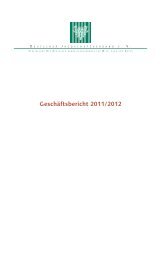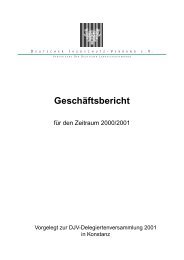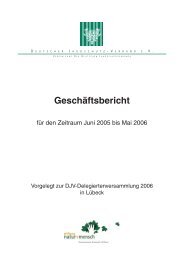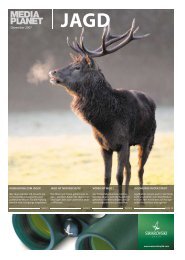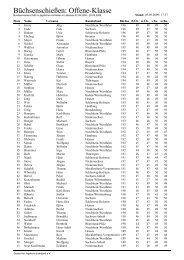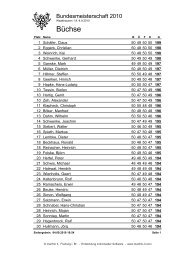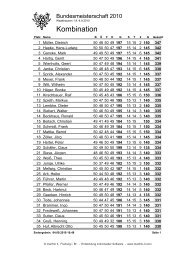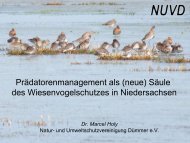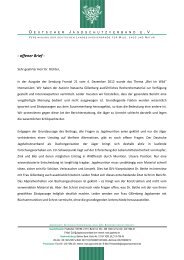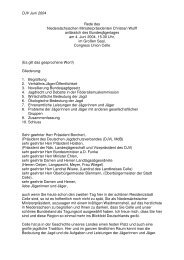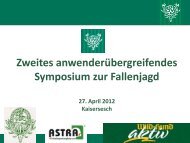TN - Newsroom.de
TN - Newsroom.de
TN - Newsroom.de
Create successful ePaper yourself
Turn your PDF publications into a flip-book with our unique Google optimized e-Paper software.
TRAPPING IN HUNGARY<br />
FANGJAGD IN UNGARN<br />
Péter Pál HAJAS<br />
Committee of Conservation and Wildlife Management<br />
Hungarian National Chamber of Hunters<br />
Institute of Wildlife Management and Vertebrate Zoology<br />
University of West Hungary
SYSTEM OF WILDLIFE MANAGEMENT IN<br />
HUNGARY<br />
• Area of Hungary: 93033 km 2 (proportion of<br />
area suitable for wildlife management: 88%)<br />
• Hol<strong>de</strong>r of the hunting rights: landowner<br />
(limit of landownership: 300ha per person)<br />
• Possible smallest extent of wildlife<br />
management units entitled to hunt: 3000ha<br />
(formation of landowners communities)<br />
• Organisations entitled to hunt: hunters’<br />
associations, landowners communities,<br />
agricultural and forestry holdings,<br />
conservation organisations covering 25% of<br />
area …<br />
• Average size of units: 7000 ha; N = 1400<br />
• Management periods: 10 years<br />
• 3 level planning system (regional and unit<br />
level for 10 years, yearly unit level)<br />
• Compulsory employment of professional<br />
hunters per 3000ha
KEY ORGANISATIONS AND INSTUTUTIONS<br />
Institute of Wildlife<br />
Management and<br />
Vertebrate Zoology<br />
University of West<br />
Hungary<br />
Wildlife Conservation<br />
Institute<br />
University of St. István<br />
Ministry of Rural Development and<br />
its Local Authorities<br />
Hungarian National<br />
Society for the Patronage<br />
of Hunting<br />
800 members in<br />
22 Territorial<br />
Organisations<br />
Hungarian National<br />
Chamber of Hunters<br />
19 county organisations<br />
of 56000 individual<br />
members<br />
National Game 3600 professional hunters<br />
Management Database
GAME SPECIES TARGETED BY TRAPPERS<br />
AND THEIR SEASONS<br />
Red fox (Vulpes vulpes Linnaeus 1758) Full year<br />
Gol<strong>de</strong>n Jackal (Canis aureus Linnaeus 1758) 06.01 – till the last day of Febr.<br />
Badger (Meles meles Linnaeus, 1758) 06.01 – till the last day of Febr.<br />
Polecat (Mustela putorius Linnaeus, 1758) 09.01 – till the last day of Febr.<br />
Stone marten (Martes foina Erxleben, 1777) 09.01 – till the last day of Febr.<br />
Raccoon dog (Nyctereutes procyoni<strong>de</strong>s Gray, 1834) Full year<br />
Raccoon (Procyon lotor Linnaeus, 1766) Full year<br />
Hoo<strong>de</strong>d crow (Corvus corone cornix Linnaeus, 1758) 07.01 – till the last day of Febr.<br />
Magpie (Pica pica Linnaeus, 1758) 07.01 – till the last day of Febr.<br />
Jay (Garullus glandarius Linnaeus 1758) 08.01 – till the last day of Febr.
NON GAME OR PROTECTED SPECIES<br />
THAT MAY BE TARGETED BY TRAPPERS<br />
NON GAME SPECIES<br />
Domestic dog (Canis familiaris Linnaeus, 1758) Un<strong>de</strong>r certain conditions<br />
Domestic cat (Felis catus Linnaeus, 1758) Un<strong>de</strong>r certain conditions<br />
Weasel (Mustela nivalis Linnaeus, 1766) Not regulated<br />
Rat (Rattus norvegicus Berkenhout 1769) Not regulated<br />
PROTECTED SPECIES<br />
(Only in case of conservation or public interest! Must be released at capture site or<br />
translocated unharmed)<br />
Pine Marten (Martes martes Linnaeus, 1758)<br />
Wild cat (Felis sylvestris Schreber, 1777)<br />
Goshawk (Accipiter gentilis Linnaeus, 1758)<br />
Commmon Buzzard (Buteo buteo Linnaeus, 1758)<br />
Marsh harrier (Circus aeruginosus Linnaeus, 1758)
WHO IS ALLOWED TO USE TRAPS?<br />
• Organisations entitled to hunt have<br />
the right to harvest game according to<br />
approved yearly management plans<br />
based on previous estimates.<br />
• Generalist predators and waterfowl<br />
have no quotas<br />
• All persons holding a valid hunting<br />
licence may use traps that are not<br />
prohibited by law to capture game,<br />
where the organisation entitled to<br />
wildlife management permits their<br />
use.<br />
• Currently no special training or<br />
licence is required for trapping.<br />
• Usually trapping is carried out by<br />
professional hunters employed by the<br />
organisations entitled to wildlife<br />
management.
WHAT MAY NOT BE USED FOR<br />
CAPTURING OF GAME<br />
• Act LV of 1996 on game conservation,<br />
willdlife management and hunting<br />
prohibits the use of snares, hooks,<br />
pitfall traps and the leghold traps<br />
banned by Council Regulation (EEC)<br />
No 3254/91.<br />
• With regard to Annex VI of the<br />
Habitats Directive (Council Directive<br />
92/43/EEC) the following methods and<br />
means of capturing or killing are<br />
prohibited also:<br />
• Non-selective means; Blind or<br />
mutilated animals used as live <strong>de</strong>coys;<br />
Nets which are non-selective according<br />
to their principle or their conditions of<br />
use; Traps which are non-selective<br />
according to their principle or their<br />
conditions of use; Poisons and poisoned<br />
or anaesthetic bait<br />
• In respect of the hunting, capture or<br />
killing of birds Article 8 of the Birds<br />
Directive (Directive 2009/147/EC),<br />
prohibits methods used for the largescale<br />
or nonselective capture or killing<br />
of birds or capable of causing the local<br />
disappearance of a species, in particular<br />
the use of those listed in Annex IV<br />
• Possible <strong>de</strong>rogations (Article 9): public<br />
health & safety, air safety, prevention<br />
of serious damage to crops, livestock,<br />
forests, fisheries & water, for the<br />
protection of flora & fauna; for the<br />
purposes of research & teaching, of repopulation,<br />
of re-introduction & for<br />
the breeding necessary for these<br />
purposes;<br />
• Strictly supervised conditions,<br />
selective basis, small numbers!
AGREEMENT ON INTERNATIONAL<br />
HUMANE TRAPPING STANDARDS<br />
• Soon to be implemented in the EU<br />
• Game species trapped in Hungary are<br />
outsi<strong>de</strong> its scope with the exception of<br />
the Badger (Meles meles)<br />
• However both restraining traps and<br />
killing traps used by trappers can be<br />
better „<strong>de</strong>fen<strong>de</strong>d” in public in case<br />
they fulfil the requirements set in<br />
AIHTS<br />
• The reintroduction of kill traps<br />
resulted in field testing of selectivity,<br />
effectiveness and user safety of the<br />
Belisle Super X 330, the 70cm (500N)<br />
and the 56cm (300N) Schwnanenhals<br />
traps in BSc and PhD studies<br />
• Cage traps have not been tested –<br />
many would probably fail welfare<br />
requirements – kill traps listed above<br />
are very likely to pass welfare<br />
requirements
AIHTS REQUIREMENTS FOR<br />
RESTRAINING AND KILLING TRAPS<br />
• Behavioural indicators of poor<br />
welfare: self-directed biting leading to<br />
severe injury (self-mutilation); excessive<br />
immobility and unresponsiveness.<br />
• Injuries indicating poor welfare:<br />
fracture; joint luxation proximal to the<br />
carpus or tarsus; severance of a tendon or<br />
ligament; major periosteal abraison;<br />
severe external haemorrhage or<br />
haemorrhage into an internal cavity;<br />
major skeletal muscle <strong>de</strong>generation; limb<br />
ischaemia; fracture of a permanent tooth<br />
exposing pulp cavity; ocular damage<br />
including corneal laceration; spinal cord<br />
injury; severe internal organ damage;<br />
myocardial <strong>de</strong>generation; amputation;<br />
<strong>de</strong>ath.<br />
• Thresholds: Target species n=20;<br />
>80% none of the indicators listed<br />
• Time limits of occurrence of<br />
unconsciousness and insensibility:<br />
• Stoat – 45 seconds<br />
• Pine marten – 120 seconds<br />
• Other animals – 300 (180) seconds<br />
• Thresholds: A killing trapping method<br />
would meet the Standards if: the<br />
number of specimens of the same<br />
target species from which the data are<br />
<strong>de</strong>rived is at least 12; and at least 80<br />
% of these animals are unconscious<br />
and insensible within the time limit,<br />
and remain in this state until <strong>de</strong>ath.
RANKING OF REASONS FOR TRAPPING<br />
1. Reduction of predation pressure on game species and protected ground nesting birds<br />
(support of recovery or reintroduction projects)<br />
2. Disease control (Veterinary and Human health aspects. e.g.. Echinococcus<br />
multilocularis)<br />
3. Scientific research<br />
4. Campaign against illegal poisoning of wildlife<br />
• Concentrated predation control effort in spring<br />
• No repopulation of territorial generalist predators<br />
• Reduction in losses during nesting and incubating
THE „CUBIC METER CAGE TRAP”<br />
• 15052 Trap Nights (<strong>TN</strong>)<br />
• Balatonfenyves (4683 <strong>TN</strong>)<br />
• Farmos (1825 <strong>TN</strong>)<br />
• Hódmezővásárhely (1282 <strong>TN</strong>)<br />
• Kozárd (7680 <strong>TN</strong>)<br />
• Szeghalom (151 <strong>TN</strong>)<br />
• Veszprémvarsány (1825 <strong>TN</strong>)<br />
• 472 captured animals<br />
• Effectiveness: 2,88 captures / 100<br />
<strong>TN</strong> (1,62 – 7,28 captures / 100 <strong>TN</strong>)
SELECTIVITY AND EFFECTIVITY OF<br />
THE „CUBIC METER CAGE TRAP”<br />
1. számú táblázat: A köbméteres ládacsapdák fogási eredményei (15053 CSÉ)<br />
Table 1.: Catch results of the „large” cage trap (15053 trap nights)<br />
Név Latin név db Fogások megoszlása (%) Fogás / 100 CSÉ<br />
Róka Vulpes vulpes 275 58,26 1,83<br />
Borz Meles meles 11 2,33 0,07<br />
Nyest Martes foina 24 5,08 0,16<br />
Kóbor kutya Canis familiaris 36 7,63 0,24<br />
Kóbor macska Felis catus 88 18,64 0,58<br />
Héja Accipiter gentilis 32 6,78 0,21<br />
Egerész ölyv Buteo buteo 5 1,06 0,03<br />
Szarka Pica pica 1 0,21 0,01<br />
Emlős ragadozók összesen 434 91,95 2,88<br />
Összesen 472 100,00 3,14
THE 70 cm SCHWANENHALS<br />
• Tested for 4163 Trap Nights (<strong>TN</strong>)<br />
• Búj 107 <strong>TN</strong><br />
• Hajdúszovát 132 <strong>TN</strong><br />
• Kozárd 1270 <strong>TN</strong><br />
• Ráckeve 199 <strong>TN</strong><br />
• Solt 435 <strong>TN</strong><br />
• Szabadszállás 1606 <strong>TN</strong><br />
• Szeghalom 228 <strong>TN</strong><br />
• Szigetszentmiklós 318 <strong>TN</strong><br />
• 233 captured specimen<br />
• Used without bunker, buried <strong>de</strong>ep,<br />
in autumn and spring<br />
• Effectiveness: 5,6 captures / 100 <strong>TN</strong><br />
(2,36 – 10,57 captures / 100 <strong>TN</strong>)
SELECTIVITY AND EFFECTIVITY OF<br />
THE 70 cm SCHWANENHALS<br />
3. számú táblázat: A 70 cm-es hattyúnyak csapda fogási eredményei (4163 CSÉ)<br />
Table 3.: Catch results of the 70 cm German body grip steel trap (4163 trap nights)<br />
Név Latin név db Fogások megoszlása (%) Fogás / 100 CSÉ<br />
Róka Vulpes vulpes 204 87,55 4,90<br />
Borz Meles meles 4 1,72 0,10<br />
Nyest Martes foina 7 3,00 0,17<br />
Házi görény Mustela putorius 2 0,86 0,05<br />
Kóbor kutya Canis familiaris 12 5,15 0,29<br />
Kóbor macska Felis catus 4 1,72 0,10<br />
Összesen 233 100,00 5,60
THE BELISLE SUPER X 330<br />
• 587 <strong>TN</strong><br />
• Apaj (118 <strong>TN</strong>)<br />
• Búj (76 <strong>TN</strong>)<br />
• Hajdúszovát (132 <strong>TN</strong>)<br />
• Kozárd (90 <strong>TN</strong>)<br />
• Szeghalom (108 <strong>TN</strong>)<br />
• Derekegyház (63<strong>TN</strong>)<br />
• 63 captures<br />
• Used on badger set entrances without<br />
cover<br />
• Effectiveness: 10,9 captures / 100 <strong>TN</strong><br />
(5,55 – 22,22 captures / 100 <strong>TN</strong>)
SELECTIVITY AND EFFECTIVITY OF<br />
THE BELISLE SUPER X 330<br />
4. számú táblázat: A forgókeretes testszorító csapda fogási eredményei (492 CSÉ)<br />
Table 4.: Catch results of the rotating jaw body grip trap (492 trap nights)<br />
Fogások megoszlása<br />
Név Latin név db<br />
(%) Fogás/100CSÉ<br />
Róka Vuleps vulpes 3 4,69 ---<br />
Borz Meles meles 61 95,31 ---<br />
Összesen<br />
64 100,00 10,90
FALSE EARTH TRAP<br />
KOZARDER ROHR-KUNSTBAU-KOMBIFALLE
TRAPS CURRENTLY UNDER TESTING<br />
„CABLE RESTRAINT DEVICES”
TRAPS TO BE TESTED – IMROVED SNARE
TRAPS TO BE TESTED – TUNNEL TRAPS
TRAINING OF TRAPPERS<br />
• As part of compulsory yearly training<br />
of professional hunters organised by<br />
the county organisations of the<br />
Hungarian National Chamber of<br />
Hunters<br />
• Organised visits to „Trap Parks” and<br />
<strong>de</strong>monstrations sites<br />
• Voluntary territorial training<br />
programmes<br />
• Case by case advisory and training<br />
• NO OFFICIAL CERTIFICATION<br />
YET!
TRAINED TRAP USERS<br />
(2012 SPRING)
FUTURE PLANS AND TASKS<br />
• TRAPPING HAS BECOME A PART<br />
OF WILDLIFE MANAGEMENT<br />
PRACTICE IN THE PAST 7 YEARS<br />
• BALANCE IS SLOWLY SHIFTING IN<br />
FAVOUR OF TRAPPING IN<br />
PREDATOR CONTROL<br />
• RESEARCH ON PREDATOR<br />
MANAGEMENT and PREDATION<br />
• DEVELOPMENT OF EFFECTIVE<br />
AND HUMANE TRAPPING<br />
METHODS<br />
• CREATION OF NATIONAL<br />
TRAPPERS ASSOCIATION<br />
• PARTICIPATION IN PUBLIC<br />
DEBATE ON DETAILED<br />
REGULATION (change in the National<br />
legislation expected by 2013 Spring)<br />
• OFFICIAL TRAINING OF TRAPPERS<br />
• PARTICIPATION IN THE WORK OF<br />
A EUROPEAN TRAPPERS<br />
PLATFORM
THANK YOU FOR YOUR KIND ATTENTION!



